Tag: media
Finlandia Prize for Fiction 2013
14 November 2013 | In the news
One of the following six novels will be awarded this year’s Finlandia Prize for Fiction, worth 30,000 euros: Ystäväni Rasputin (’My friend Rasputin’) by JP Koskinen, Hotel Sapiens (Teos) by Leena Krohn, Jokapäiväinen elämämme (‘Our everyday life’, Teos) by Riikka Pelo, Terminaali (‘The terminal’, Siltala) by Hannu Raittila, Herodes (‘Herod’, WSOY) by Asko Sahlberg and Hägring 38 (‘Mirage 38’, Schildts & Söderströms; Finnish translation, Kangastus, Otava) by Kjell Westö.
Half of the writers have already won the Finlandia Prize once, namely Krohn (1992), Raittila (2001) and Westö (2006).
Four of the six works deal with a historical character or history: Koskinen with the Russian ‘holy man’ Rasputin, Pelo with the Russian poet Marina Tsvetaeva, Sahlberg with Herod the Great of Judea. Westö goes back to the year 1938 in Finland.
Raittila’s realistic novel takes place on contemporary airports. Krohn, again taking a look at an unknown future, presents the reader with a imaginary Earth which no longer is habitable to humans.
The runners-up were chosen by a jury – appointed by the Finnish Book Publishers’ Association – of three: the journalists Nina Paavolainen and Raisa Rauhamaa and the translator Juhani Lindholm. The winner of the 30th Finlandia Prize for Fiction will chosen by theatre manager of the Helsinki City Theatre and actor Asko Sarkola, and announced on 3 December.
Truth or hype: good books or bad reviews?
8 November 2013 | Letter from the Editors

‘The Bibliophile’s Desk’: L. Block (1848–1901). Wikipedia
More and more new Finnish fiction is seeing the light of day. Does quantity equal quality?
Fewer and fewer critical evaluations of those fiction books are published in the traditional print media. Is criticism needed any more?
At the Helsinki Book Fair in late October the latest issue of the weekly magazine Suomen Kuvalehti was removed from the stand of its publisher, Otavamedia, by the chief executive officer of Otava Publishing Company Ltd. Both belong to the same Otava Group.
The cover featured a drawing of a book in the form of a toilet roll, referring to an article entitled ‘The ailing novel’, by Riitta Kylänpää, in which new Finnish fiction and literary life were discussed, with a critical tone at places. CEO Pasi Vainio said he made the decision out of respect for the work of Finnish authors.
His action was consequently assessed by the author Elina Hirvonen who, in her column in the Helsingin Sanomat newspaper, criticised the decision. ‘The attempt to conceal the article was incomprehensible. Authors are not children. The Finnish novel is not doing so badly that it collapses if somebody criticises it. Even a rambling reflection is better for literature than the same old articles about the same old writers’ personal lives.’ More…
Cool, not ice-cool
17 October 2013 | This 'n' that
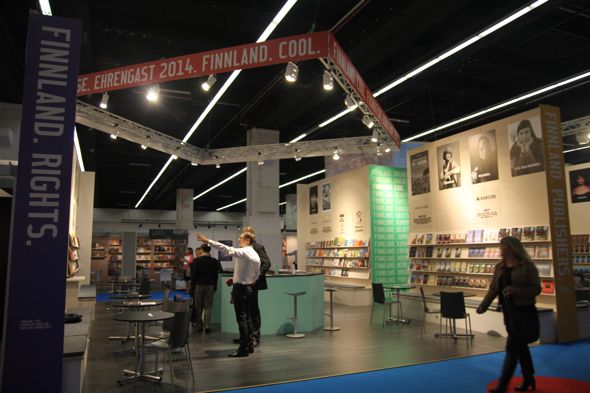
Getting ready: book fair scenery, 2013. Photo: FILI
The Finnish book world is preparing for the big event of ‘F14’: Finland will appear as Guest of Honour at the Frankfurt Book Fair in October next year.
The slogan for this enterprise is Finnland. Cool.
The coordinating organ is FILI, the Finnish Literature Exchange, a part of the Finnish Literature Society. Co-operating with FILI are three ministries, literary organisations and publishers, the Finnish Embassy and Finnland-Institut in Berlin and the Goethe-Institut in Helsinki.
Last week a large proportion of the FILI staff – who now need to keep their cool for the next busy year – went to Frankfurt, and on 10 October (aptly, the memorial day of the national author Aleksis Kivi and also Finnish Literature Day) the press conference was opened by the Finnish Minister of Culture and Sport, Paavo Arhinmäki. On 13 October the 2013 Guest of Honour, Brazil, passed the baton to Finland. (More photographs here.)
The world’s largest book fair, Frankfurt, attracts some 300,000 visitors each year. Accessible to both professionals and the general public, the fair is also the biggest cultural event in Germany.
The Guest of Honour countries receive a vast amount of attention in the media, and the number of new translations from the respective languages into German, as well as other languages, will increase.
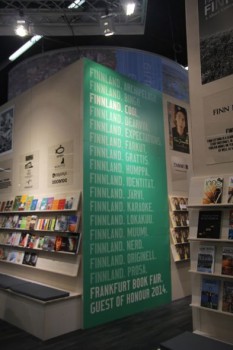
Finnland: arktik. Blondi. Cool. Demokratia. Einsam. Formula 1. Girji. Heimat. Ihminen. Joy…. Photo: FILI
The total Finnish budget for the years 2010–2015 is approximately four million euros, half of it money from the government. And the mission? Here are some warm words from the cool FILI agenda:
‘Why are Finns reading so much? Why are Finns so good at reading? Because we love it. Because reading plays such an important role in everyday life.
‘And because it is so important in Finland that everybody has access to reading – regardless of whether you are male or female, where you live, where you work, what your education or talent is. Fun, everyday life and for everyone – these are the main themes of the satellite programme for the Guest of Honour at the Frankfurt Book Fair 2014.’
What have brains got to do with it?
17 October 2013 | Columns, Tales of a journalist
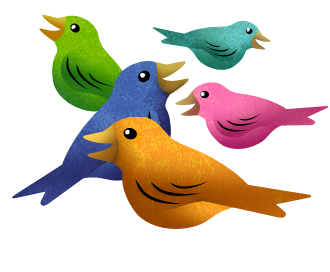
Illustration: Joonas Väänänen
Pondering his changing profession once again, columnist and media critic Jyrki Lehtola feels compelled to present a brief history of the media
Not long ago a certain media company invited me to participate in a panel on brainprints.
I didn’t know what they were talking about, so I agreed. At most I thought it was about the engram left in our collective psyche that yes, we used to have this sort of print media thing that told us what the world was like.
And then we didn’t – look at this picture of print media on my iPad, kids, isn’t it cute?
That wasn’t what it was about at all. Brainprint means all the ways the media can influence us as consumers. In other words, this is one more conversation the media has with itself to convince itself that it has a role to play.
There we sat around a long table once again talking about whether the media is a mirror or a window when maybe we should have been talking about the pile of glass on the ground and whether someone shouldn’t clean it up before someone hurts themselves. More…
Cut time, paste space
12 September 2013 | Articles, Non-fiction

Back to basics. Parts of a musical note. Picture: Wikimedia
How different are the art of words and the art of sounds, author Teemu Manninen ponders, as he unexpectedly finds himself in the role of a musician in a performance. Time, space or both?
Some time ago I got the chance to participate in an unusual concert – as a performer: six players, myself included, were grouped around a table with a triangle in one hand and a glove in the other. Pieces of dry ice and a bucket of water were placed in front of each of us.
The performance began: we took a piece of dry ice and pressed it against the triangle. As the metal cooled, it burned through the ice, releasing gas, which in turn made the metal vibrate very fast. This produced a keening sound that filled the room. More…
Expat, fun
30 August 2013 | In the news
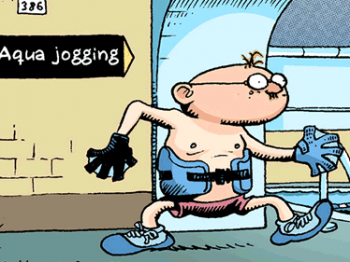
Popular Finnish aqua sports à la Pertti Jarla
Expat Finland, created by Stuart Allt – an Australian web designer living in Turku, Finland – is an information resource on the Internet. It is particularly useful for people moving to Finland, or for anyone who is interested in finding out about Finnish services and products and in living in the country in general.
If you’re looking for maps, restaurants or universities, are interested in knowing more about the language(s), culture, sports etc, take a look at the recently redesigned Expat Finland.
And what do Finns think is funny?
Among latest additions on the Expat site is a selection of comic strips by Pertti Jarla. The creator of the cartoon town Fingerpori is often impossible to translate as he constantly plays with words and their meanings (getting the joke sometimes takes a while, too).
Take also a look at the samples of Jarla’s illustrations to Zoo – eläimellinen tarina (‘Zoo – a bestial story’), a book for children by Roman Schatz and Jarla, featured in Books from Finland.
Grown-up talk
13 June 2013 | Non-fiction, Tales of a journalist

Illustration: Joonas Väänänen
Would you say this to someone face to face? No? But anonymously, in writing, you do. Columnist Jyrki Lehtola takes a look at the way Finns tend to behave on the Internet
Babies. They’re cute. They have to be – they are babies after all. And their parents are lovely people, because they have those cute babies. Even they have a hard time believing how mellow and happy they are now that they have a baby.
But what happens to parents when the baby falls asleep and they get to creep off to the Internet? They completely freak out and turn into belligerent trolls. More…
Designbites
26 April 2013 | This 'n' that
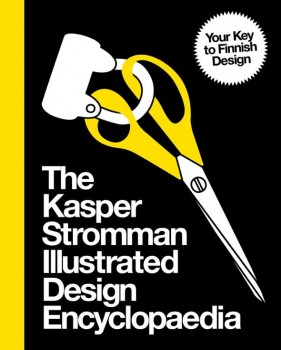 Hey, design hipsters, wherever you are – after the super-serious focus brought about by Helsinki’s year as World Design Capital 2012, here’s a way to blow off steam.
Hey, design hipsters, wherever you are – after the super-serious focus brought about by Helsinki’s year as World Design Capital 2012, here’s a way to blow off steam.
Written by the comic-strip artist, illustrator and designer Kasper Strömman (born 1974), The Kasper Stromman Illustrated Design Encyclopedia (HuudaHuuda, 2013) consists of a series of post-ironic sound-bites on Finnish material culture.
Strömman was voted Graphic Designer of 2013 in Finland by Grafia (Association of Visual Communication Designers), by a jury that considered him to be a ‘catalyst, challenger and the standup comedian of graphic design’.
His book really is encyclopaedic, with entries ranging from the usual suspects (Artek, Arabia, Iittala) through the iconoclastic (in purist design terms, anyway: Angry Birds, the heteka sofa bed, Nokia gumboots and mobile phones) and the everyday (hapankorppu crispbread, vihreä kuula sweets, the Anttila mail-order catalogue and store) to the just plain wacky (the Aqua Tube disposable toilet roll, the Konrad ReijoWaara bridge, the Superlon mattress).
There are also fun sections on how to make your own design classics – for example, a pair of original orange Fiskars scissors (just use some paint) or Harri Koskinen’s glass block lamp – and outings to less-than-fashionable destinations (in eastern Helsinki) such as the Puhos shopping centre or the Itä-Pasila housing estate.
And so on. You can get a taste of what to expect at Kasper Strömman’s design blog in English (sadly discontinued, although it remains online. He’s started a new blog, although only in Finnish, entitled Kasper Diem…).
So far, so good; we like the idea, and it’s hard to think of another source that succeeds so well in bringing together every material thing we think of as Finnish. The problem is that it’s all delivered in faintly annoying one-liners – Kalevala Koru makes ‘jewellery based on bronze age findings, usually bought for you by your parents’; the Jugend style of architecture ‘should not be confused with “Hitler Jugend”’; Lapponia, Lapland in Latin, ‘useful to know if you were planning a ski trip in the Middle Ages’ – quite funny at first, but in the end they begin to get on your nerves. It’s like a diet of street food that never quite adds up to a meal.
The book’s foreword claims it to be ‘unique in the sense that it was put together with a minimum amount of research’ – no designers’ names or information-based facts. There’s an advantage here – it means that Strömman has felt free to include, among his opinions, plenty of oral and hearsay information, essential in dealing with everyday objects and their meanings.
But it also means that, too often, the author has let himself off the hook with a gag or a quip when staying with the subject would have been really rewarding. It’s a bit too much like material culture with attention deficit disorder. (It’s also hard to see who the book is really directed at – many of the jokes are so ‘in’ that it’s only those who are already in the know who will appreciate them.)
So hey, guys (Strömman refers to himself in the plural, so we will too), how about a challenge? Why not take yourselves seriously, and write the full-out version?
Fatherlands, mother tongues?
12 April 2013 | Letter from the Editors

Patron saint of translators: St Jerome (d. 420), translating the Bible into Latin. Pieter Coecke van Aelst, ca 1530. Walters Art Museum, Baltimore. Photo: Wikipedia
Finnish is spoken mostly in Finland, whereas English is spoken everywhere. A Finnish writer, however, doesn’t necessarily write in any of Finland’s three national languages (Finnish, Swedish and Sámi).
What is a Finnish book, then – and (something of particular interest to us here at the Books from Finland offices) is it the same thing as a book from Finland? Let’s take a look at a few examples of how languages – and fatherlands – fluctuate.
Hannu Rajaniemi has Finnish as his mother tongue, but has written two sci-fi novels in English, which were published in England. A Doctor in Physics specialising in string theory, Rajaniemi works at Edinburgh University and lives in Scotland. His books have been translated into Finnish; the second one, The Fractal Prince / Fraktaaliruhtinas (2012) was in March 2013 on fifth place on the list of the best-selling books in Finland. (Here, a sample from his first book, The Quantum Thief, 2011, Gollancz.)
Emmi Itäranta, a Finn who lives in Canterbury, England, published her first novel, Teemestarin tarina (‘The tea master’s book’, Teos, 2012), in Finland. She rewrote it in English and it will be published as Memory of Water in England, the United States and Australia (HarperCollins Voyager) in 2014. Translations into six other languages will follow. More…
Love me tender… in Latin
12 April 2013 | This 'n' that
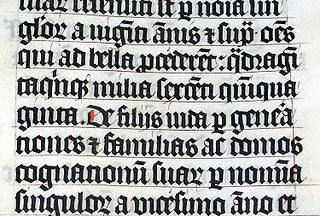
Latin Bible, 1407. Malmesbury Abbey, Wiltshire, UK. Photo: Arpingstone, Wikipedia
Nuntii Latini, conspectus rerum internationalium hebdomadalis, est programma Radiophoniae Finnicae Generalis in terrarum orbe unicum.
Nuntii Latini is a five-minute radio programme broadcast every Friday by the Finnish Broadcasting Company, YLE. It is the only regular news programme in Latin in the world, and has been on the air since 1989. (Not even Vatican Radio broadcasts news.)
Professor Tuomo Pekkanen from Jyväskylä University and Reijo Pitkäranta are the founding fathers of the programme, and they are helped by some other friends of Latin.
In a report on 8 April The New York Times wrote that even Elvis Presley has inspired the friends of the dead language: Jukka Ammondt, a Finnish university lecturer in English and German, began singing Elvis songs in Latin a couple of decades ago, and occasionally still does. Love Me Tender: Tenere Me Ama.
John Tagliabue describes in his article how Leah Whittington, an English professor at Harvard, ‘catches the news bulletins on her iPod while strolling to classes.’ Whittington says: ‘I’m often struck when I’m listening how well structured they are, how idiomatic, how precise the vocabulary is.’
The editors don’t invent new words, they look for new expressions using existing Latin vocabulary. A golf course, for example, is campus pilamallei.
The human factor
14 March 2013 | Non-fiction, Tales of a journalist
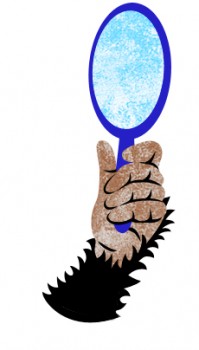
Illustration: Joonas väänänen
Columnist Jyrki Lehtola zooms in on the worst factor in the diminishing quality journalism: us. Our voice is now dominant in the media, and it isn’t a particularly pleasant one.
Have you heard the rumours about the crisis in the media yet? Or their search for a new revenue logic that consists of repeating the words ‘Internet’ and ‘money’? I’m sure you have, even though the media itself claims to be getting along fairly well and can always find some perspective on its dropping circulation numbers that tells everyone they’re doing just fine. (For example, their numbers are better than in 1898 when the paper didn’t exist. Yes, we rule!)
But that isn’t the only problem. The other problem exists in us, the readers, listeners and viewers. Social media, discussion boards, and the media itself have given us a voice, and, er, well, it isn’t the kind of voice anyone wants to hear.
It turned out we have an ugly voice, and we want all the wrong things. More…
New member of the Books from Finland team
7 March 2013 | In the news
Kristina Malmio is the new member of the Editorial Board of Books from Finland. She replaces Jarmo Papinniemi, who died last October. Kristina is a literary scholar and associate professor at Helsinki University as well as a critic who writes in both Swedish and Finnish. Her doctoral thesis (Department of Nordic Literature, University of Helsinki, 2005) examined metafictive features in Finnish and Finland-Swedish popular literature in the 1910s and 1920s. She has been a member of the Nordic Council literary prize jury since 2006.
Kristina is particularly fond of new Finnish poetry, good coffee and astanga yoga.
More light! Mehr Licht!
10 January 2013 | In the news

Light and colour: ‘Emergence’ by Casa Magica. Photo: Lux Helsinki / Hannu Iso-oja
With the winter solstice now over, the darkness will begin to diminish, albeit very slowly: additional artificial light is still much appreciated. Fiat lux! The early days of the new year Lux Helsinki (from 4 to 8 Jan) brought light and colour to the city-dwellers in the form of 13 light installations in various parts of the city.
The Cathedral was lit by the German duo Casa Magica – light designers Friedrich Förster and Sabine Weißinger – whose work entitled ‘Emergence’ painted the church with fantastic shapes and colours. One of the works was an illuminated, silvery tram – unfortunately it was not possible to get on board though.
Among the other works of light art was the recently opened and very popular Baana, an old train track now serving as a passageway for cyclists and pedestrians through the city centre: the creation entitled ‘Reveal’ by the London-based media artist Dan Shorten made the stone walls change colour and the total mood of Baana.

Paint with colour: ‘Reveal’ by Dan Shorten. Photo: Lux Helsinki / Hannu Iso-oja
A pity Lux Helsinki – staged now for the fifth time – lasts for a few days only, as it will take a while for the increase of daylight to be apparent….
Mind the gaffe
14 December 2012 | Non-fiction, Tales of a journalist
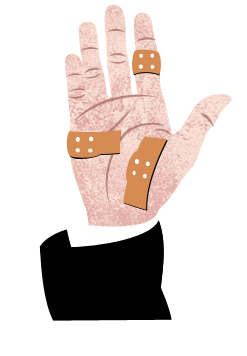
Illustration: Joonas Väänänen
Celebrating Finnish Independence Day is a serious business involving lots of handshakes and plenty of pitfalls for the unwary, observes columnist Jyrki Lehtola. But luckily there’s plenty of fun to be had for ordinary Finns in complaining about it all
When Finland makes the news, it’s usually because of a national tragedy or something odd we do. The latter ripe fodder for filling the blank pages of the international media on slow news days includes such things as the Finnish penchant for competitions in such sporting events as Wellington boot /mobile phone tossing (saappaan- / kännykänheitto) and wife carrying (akankanto).
We have another odd national tradition, although it has never received as much international recognition as the fact that we carry our wives competitively. This time- honoured custom repeats annually on the sixth of December, when we close our shops and barricade ourselves gloomily within our homes. Its name is Independence Day. More…
Celebrity boobs and other news
9 October 2012 | Non-fiction, Tales of a journalist

Illustration: Joonas Väänänen
Anyone can find the latest news and the vital information he or she requires – latest pictures of some celebrity’s breasts, the reasons why men cheat on their wives – immediately from the Internet. Jyrki Lehtola takes a look at why the printed media are in trouble
We are living in an age of newspaper death. Several publications have already closed up shop in Finland just this autumn. The most notable of these was Finland’s oldest and most influential teen magazine, Suosikki (‘Favourite’), which had been in circulation for some 52 years.
This was where several generations, particularly the boys of several generations, got all of their information about sex, where they learned how to tape posters to their walls without them peeling off, where they got information about rock stars’ drug use and favourite foods and where they learned that even if something can be expressed with a period, expressing it with an exclamation point is still preferable. More…
